Research in Business: Decentralization and Employee Performance
VerifiedAdded on 2021/04/21
|19
|4465
|45
Report
AI Summary
This research proposal investigates the impact of a decentralized management system on employee performance within the Tata Group of Companies. It begins with an introduction to management systems and the rationale for decentralization in multinational organizations. The problem statement highlights the limitations of centralized systems in today's competitive global market. The research aims to identify the benefits of decentralization, evaluate influencing factors, and examine its effects on employees. The methodology employs a positivism philosophy and a deductive approach, utilizing a descriptive research design and a qualitative research strategy with interviews. The conceptual framework reviews literature on decentralization, its factors, and its impact on decision-making and employee motivation. The proposal outlines the sampling technique, data collection methods, and ethical considerations. The study anticipates that decentralization will be found effective, contributing to organizational growth and improved decision-making. The project includes a budget and a Gantt chart for effective project management and completion.

Running head: RESEARCH IN BUSINESS
RESEARCH IN BUSINESS
Topic: The Impact of Decentralization of Management System on Employee’s Performance
in the Tata Group of Company
Name of the Student:
Name of the University:
Author Note:
RESEARCH IN BUSINESS
Topic: The Impact of Decentralization of Management System on Employee’s Performance
in the Tata Group of Company
Name of the Student:
Name of the University:
Author Note:
Paraphrase This Document
Need a fresh take? Get an instant paraphrase of this document with our AI Paraphraser
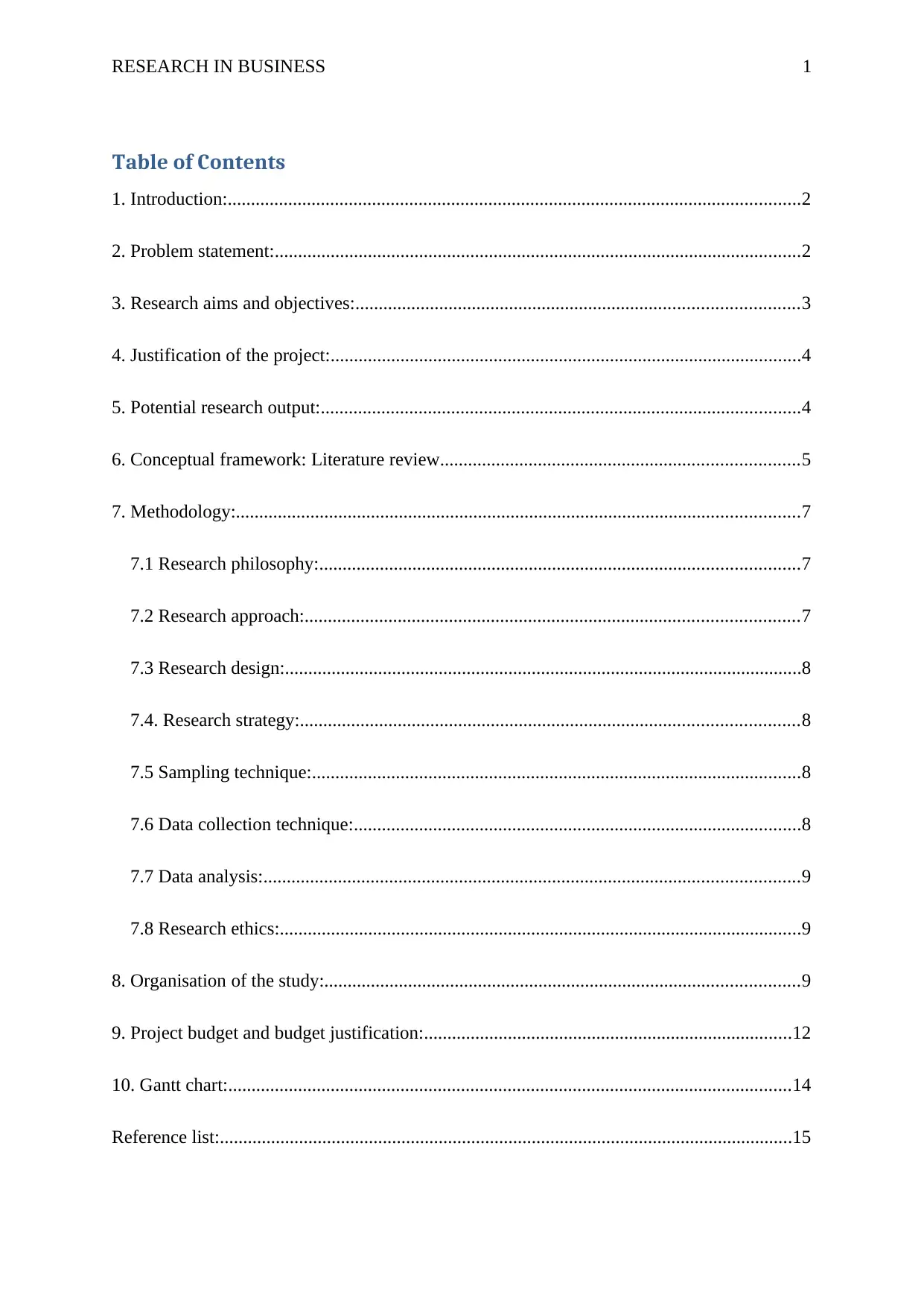
RESEARCH IN BUSINESS 1
Table of Contents
1. Introduction:...........................................................................................................................2
2. Problem statement:.................................................................................................................2
3. Research aims and objectives:...............................................................................................3
4. Justification of the project:.....................................................................................................4
5. Potential research output:.......................................................................................................4
6. Conceptual framework: Literature review.............................................................................5
7. Methodology:.........................................................................................................................7
7.1 Research philosophy:.......................................................................................................7
7.2 Research approach:..........................................................................................................7
7.3 Research design:...............................................................................................................8
7.4. Research strategy:...........................................................................................................8
7.5 Sampling technique:.........................................................................................................8
7.6 Data collection technique:................................................................................................8
7.7 Data analysis:...................................................................................................................9
7.8 Research ethics:................................................................................................................9
8. Organisation of the study:......................................................................................................9
9. Project budget and budget justification:...............................................................................12
10. Gantt chart:.........................................................................................................................14
Reference list:...........................................................................................................................15
Table of Contents
1. Introduction:...........................................................................................................................2
2. Problem statement:.................................................................................................................2
3. Research aims and objectives:...............................................................................................3
4. Justification of the project:.....................................................................................................4
5. Potential research output:.......................................................................................................4
6. Conceptual framework: Literature review.............................................................................5
7. Methodology:.........................................................................................................................7
7.1 Research philosophy:.......................................................................................................7
7.2 Research approach:..........................................................................................................7
7.3 Research design:...............................................................................................................8
7.4. Research strategy:...........................................................................................................8
7.5 Sampling technique:.........................................................................................................8
7.6 Data collection technique:................................................................................................8
7.7 Data analysis:...................................................................................................................9
7.8 Research ethics:................................................................................................................9
8. Organisation of the study:......................................................................................................9
9. Project budget and budget justification:...............................................................................12
10. Gantt chart:.........................................................................................................................14
Reference list:...........................................................................................................................15
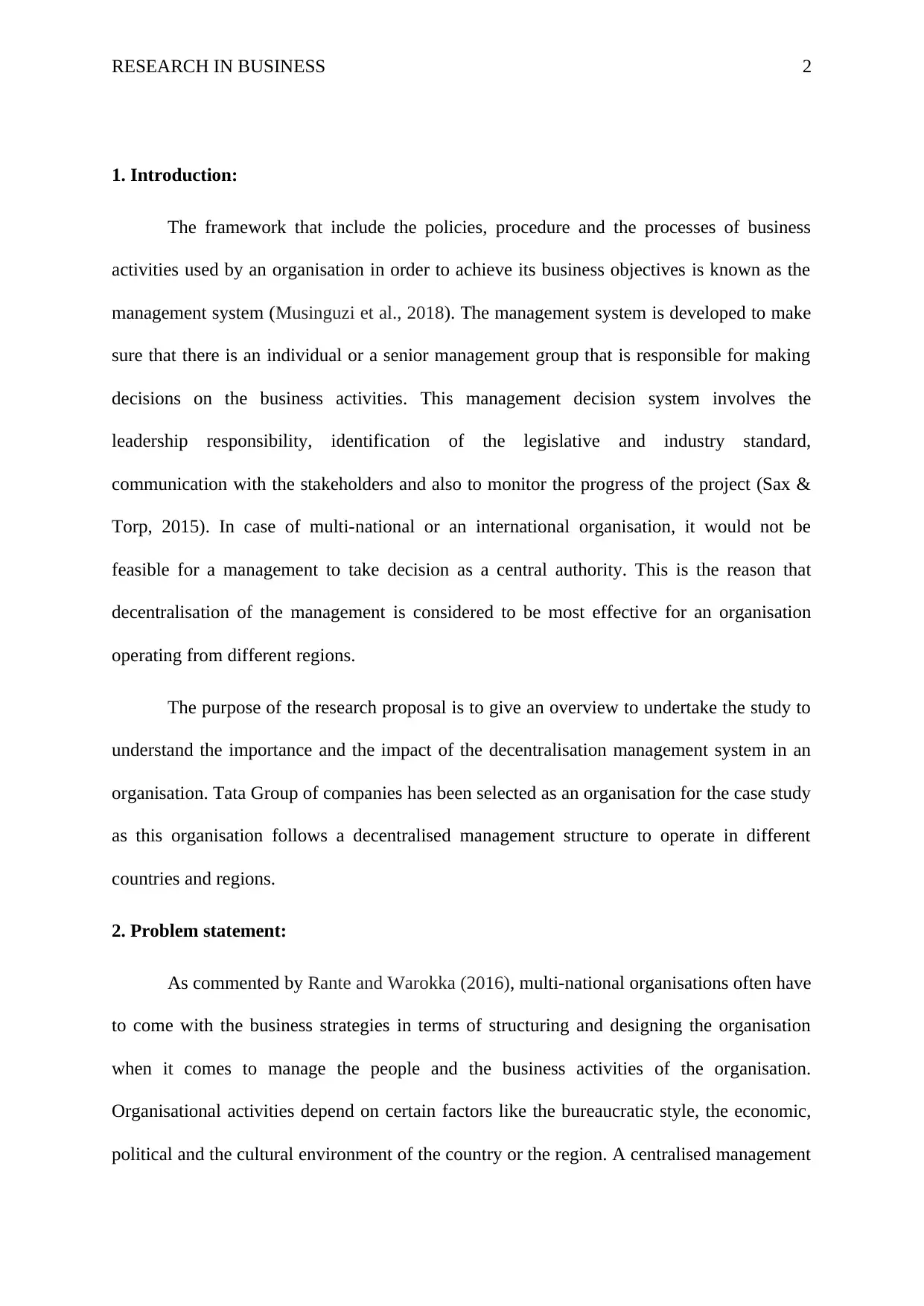
RESEARCH IN BUSINESS 2
1. Introduction:
The framework that include the policies, procedure and the processes of business
activities used by an organisation in order to achieve its business objectives is known as the
management system (Musinguzi et al., 2018). The management system is developed to make
sure that there is an individual or a senior management group that is responsible for making
decisions on the business activities. This management decision system involves the
leadership responsibility, identification of the legislative and industry standard,
communication with the stakeholders and also to monitor the progress of the project (Sax &
Torp, 2015). In case of multi-national or an international organisation, it would not be
feasible for a management to take decision as a central authority. This is the reason that
decentralisation of the management is considered to be most effective for an organisation
operating from different regions.
The purpose of the research proposal is to give an overview to undertake the study to
understand the importance and the impact of the decentralisation management system in an
organisation. Tata Group of companies has been selected as an organisation for the case study
as this organisation follows a decentralised management structure to operate in different
countries and regions.
2. Problem statement:
As commented by Rante and Warokka (2016), multi-national organisations often have
to come with the business strategies in terms of structuring and designing the organisation
when it comes to manage the people and the business activities of the organisation.
Organisational activities depend on certain factors like the bureaucratic style, the economic,
political and the cultural environment of the country or the region. A centralised management
1. Introduction:
The framework that include the policies, procedure and the processes of business
activities used by an organisation in order to achieve its business objectives is known as the
management system (Musinguzi et al., 2018). The management system is developed to make
sure that there is an individual or a senior management group that is responsible for making
decisions on the business activities. This management decision system involves the
leadership responsibility, identification of the legislative and industry standard,
communication with the stakeholders and also to monitor the progress of the project (Sax &
Torp, 2015). In case of multi-national or an international organisation, it would not be
feasible for a management to take decision as a central authority. This is the reason that
decentralisation of the management is considered to be most effective for an organisation
operating from different regions.
The purpose of the research proposal is to give an overview to undertake the study to
understand the importance and the impact of the decentralisation management system in an
organisation. Tata Group of companies has been selected as an organisation for the case study
as this organisation follows a decentralised management structure to operate in different
countries and regions.
2. Problem statement:
As commented by Rante and Warokka (2016), multi-national organisations often have
to come with the business strategies in terms of structuring and designing the organisation
when it comes to manage the people and the business activities of the organisation.
Organisational activities depend on certain factors like the bureaucratic style, the economic,
political and the cultural environment of the country or the region. A centralised management
⊘ This is a preview!⊘
Do you want full access?
Subscribe today to unlock all pages.

Trusted by 1+ million students worldwide
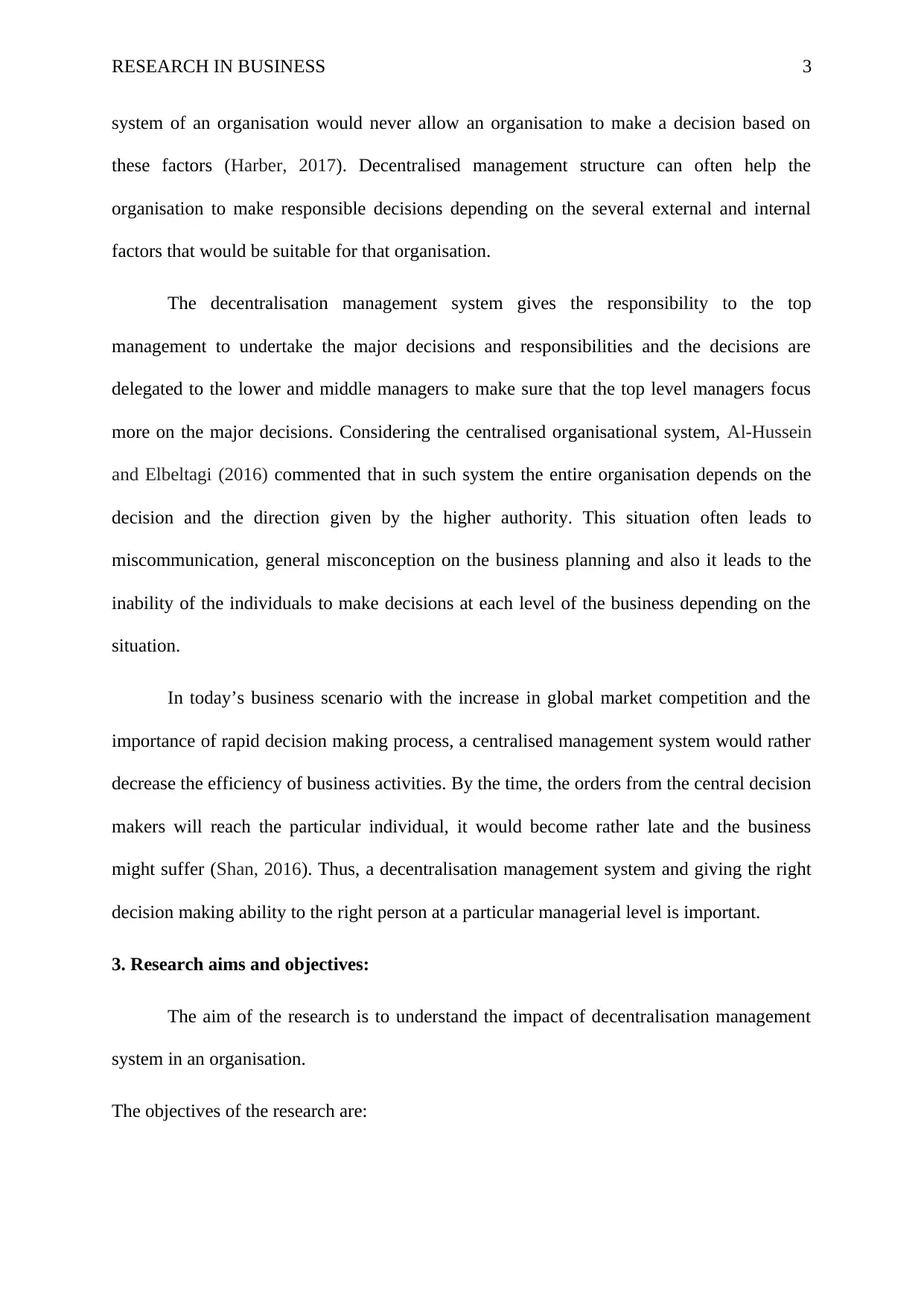
RESEARCH IN BUSINESS 3
system of an organisation would never allow an organisation to make a decision based on
these factors (Harber, 2017). Decentralised management structure can often help the
organisation to make responsible decisions depending on the several external and internal
factors that would be suitable for that organisation.
The decentralisation management system gives the responsibility to the top
management to undertake the major decisions and responsibilities and the decisions are
delegated to the lower and middle managers to make sure that the top level managers focus
more on the major decisions. Considering the centralised organisational system, Al-Hussein
and Elbeltagi (2016) commented that in such system the entire organisation depends on the
decision and the direction given by the higher authority. This situation often leads to
miscommunication, general misconception on the business planning and also it leads to the
inability of the individuals to make decisions at each level of the business depending on the
situation.
In today’s business scenario with the increase in global market competition and the
importance of rapid decision making process, a centralised management system would rather
decrease the efficiency of business activities. By the time, the orders from the central decision
makers will reach the particular individual, it would become rather late and the business
might suffer (Shan, 2016). Thus, a decentralisation management system and giving the right
decision making ability to the right person at a particular managerial level is important.
3. Research aims and objectives:
The aim of the research is to understand the impact of decentralisation management
system in an organisation.
The objectives of the research are:
system of an organisation would never allow an organisation to make a decision based on
these factors (Harber, 2017). Decentralised management structure can often help the
organisation to make responsible decisions depending on the several external and internal
factors that would be suitable for that organisation.
The decentralisation management system gives the responsibility to the top
management to undertake the major decisions and responsibilities and the decisions are
delegated to the lower and middle managers to make sure that the top level managers focus
more on the major decisions. Considering the centralised organisational system, Al-Hussein
and Elbeltagi (2016) commented that in such system the entire organisation depends on the
decision and the direction given by the higher authority. This situation often leads to
miscommunication, general misconception on the business planning and also it leads to the
inability of the individuals to make decisions at each level of the business depending on the
situation.
In today’s business scenario with the increase in global market competition and the
importance of rapid decision making process, a centralised management system would rather
decrease the efficiency of business activities. By the time, the orders from the central decision
makers will reach the particular individual, it would become rather late and the business
might suffer (Shan, 2016). Thus, a decentralisation management system and giving the right
decision making ability to the right person at a particular managerial level is important.
3. Research aims and objectives:
The aim of the research is to understand the impact of decentralisation management
system in an organisation.
The objectives of the research are:
Paraphrase This Document
Need a fresh take? Get an instant paraphrase of this document with our AI Paraphraser
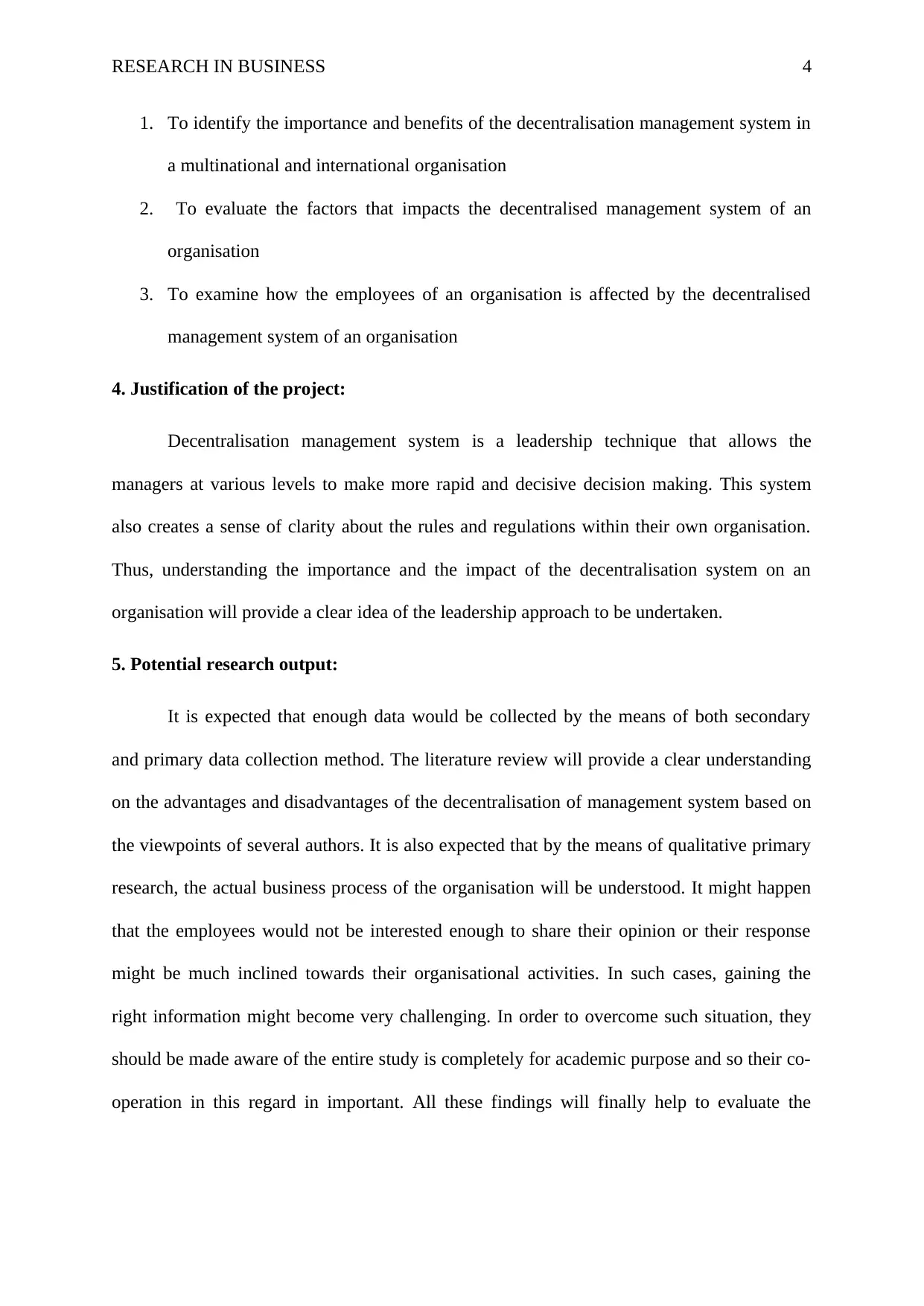
RESEARCH IN BUSINESS 4
1. To identify the importance and benefits of the decentralisation management system in
a multinational and international organisation
2. To evaluate the factors that impacts the decentralised management system of an
organisation
3. To examine how the employees of an organisation is affected by the decentralised
management system of an organisation
4. Justification of the project:
Decentralisation management system is a leadership technique that allows the
managers at various levels to make more rapid and decisive decision making. This system
also creates a sense of clarity about the rules and regulations within their own organisation.
Thus, understanding the importance and the impact of the decentralisation system on an
organisation will provide a clear idea of the leadership approach to be undertaken.
5. Potential research output:
It is expected that enough data would be collected by the means of both secondary
and primary data collection method. The literature review will provide a clear understanding
on the advantages and disadvantages of the decentralisation of management system based on
the viewpoints of several authors. It is also expected that by the means of qualitative primary
research, the actual business process of the organisation will be understood. It might happen
that the employees would not be interested enough to share their opinion or their response
might be much inclined towards their organisational activities. In such cases, gaining the
right information might become very challenging. In order to overcome such situation, they
should be made aware of the entire study is completely for academic purpose and so their co-
operation in this regard in important. All these findings will finally help to evaluate the
1. To identify the importance and benefits of the decentralisation management system in
a multinational and international organisation
2. To evaluate the factors that impacts the decentralised management system of an
organisation
3. To examine how the employees of an organisation is affected by the decentralised
management system of an organisation
4. Justification of the project:
Decentralisation management system is a leadership technique that allows the
managers at various levels to make more rapid and decisive decision making. This system
also creates a sense of clarity about the rules and regulations within their own organisation.
Thus, understanding the importance and the impact of the decentralisation system on an
organisation will provide a clear idea of the leadership approach to be undertaken.
5. Potential research output:
It is expected that enough data would be collected by the means of both secondary
and primary data collection method. The literature review will provide a clear understanding
on the advantages and disadvantages of the decentralisation of management system based on
the viewpoints of several authors. It is also expected that by the means of qualitative primary
research, the actual business process of the organisation will be understood. It might happen
that the employees would not be interested enough to share their opinion or their response
might be much inclined towards their organisational activities. In such cases, gaining the
right information might become very challenging. In order to overcome such situation, they
should be made aware of the entire study is completely for academic purpose and so their co-
operation in this regard in important. All these findings will finally help to evaluate the
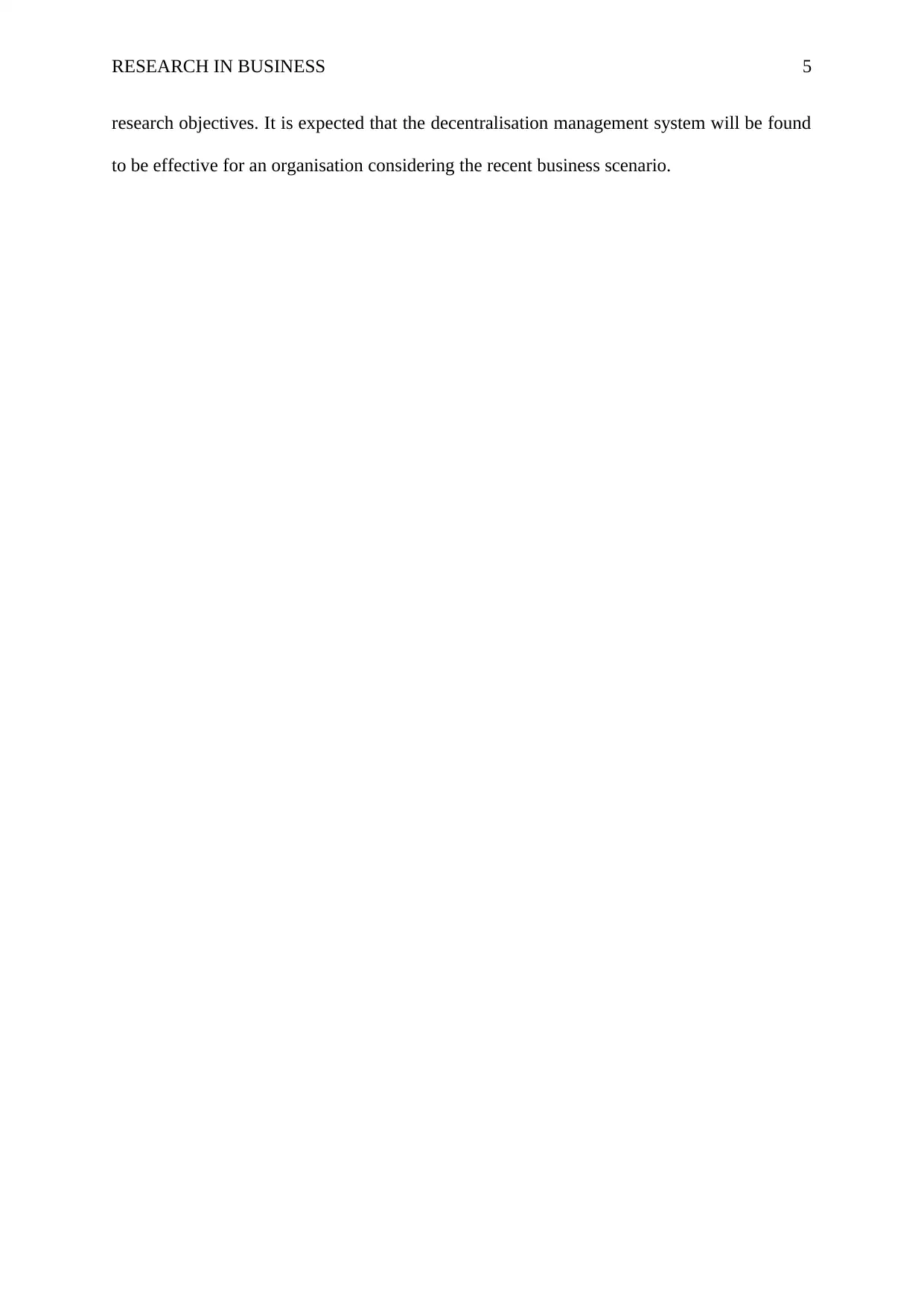
RESEARCH IN BUSINESS 5
research objectives. It is expected that the decentralisation management system will be found
to be effective for an organisation considering the recent business scenario.
research objectives. It is expected that the decentralisation management system will be found
to be effective for an organisation considering the recent business scenario.
⊘ This is a preview!⊘
Do you want full access?
Subscribe today to unlock all pages.

Trusted by 1+ million students worldwide

RESEARCH IN BUSINESS 6
6. Conceptual framework: Literature review
Fig: The conceptual framework
(Source: Self developed)
In the view point of Ngo, De Boer and Enders (2015), decentralisation is the process
when the authorities are transformed to the managers at different levels giving decision
making abilities to the managers in the lower and middle level of an organisation. There are
certain factors based on which the concept of the decentralisation is imposed in an
organisation; the most important factor being the size of the organisation. Decentralisation of
the organisation will naturally become important when the size of the organisation will
increase because an organisation cannot be managed from a leader or manager from a central
position (Ólafsson, 2016). In such cases, it becomes very important that maximum power is
given to the manager or the individual at the particular branch rather than relying on a
particular person at the centre. In this respect, Soodan et al., (2017) commented that it is
again challenging for the management to manage the organisation if the manager is not
efficient enough to handle the situation. Contradicting this point, Weston (2015) commented
that decentralisation of the organisation actually helps in improving the management and the
decision making of the managers at any level. It is always a matter of experience and
knowledge that an individual at the management level gains in order to improve the decision
making skills and ability. Therefore, in a way this management system can actually act as a
6. Conceptual framework: Literature review
Fig: The conceptual framework
(Source: Self developed)
In the view point of Ngo, De Boer and Enders (2015), decentralisation is the process
when the authorities are transformed to the managers at different levels giving decision
making abilities to the managers in the lower and middle level of an organisation. There are
certain factors based on which the concept of the decentralisation is imposed in an
organisation; the most important factor being the size of the organisation. Decentralisation of
the organisation will naturally become important when the size of the organisation will
increase because an organisation cannot be managed from a leader or manager from a central
position (Ólafsson, 2016). In such cases, it becomes very important that maximum power is
given to the manager or the individual at the particular branch rather than relying on a
particular person at the centre. In this respect, Soodan et al., (2017) commented that it is
again challenging for the management to manage the organisation if the manager is not
efficient enough to handle the situation. Contradicting this point, Weston (2015) commented
that decentralisation of the organisation actually helps in improving the management and the
decision making of the managers at any level. It is always a matter of experience and
knowledge that an individual at the management level gains in order to improve the decision
making skills and ability. Therefore, in a way this management system can actually act as a
Paraphrase This Document
Need a fresh take? Get an instant paraphrase of this document with our AI Paraphraser

RESEARCH IN BUSINESS 7
motivation for the managers at the various levels and there would be a development in the
overall organisational activities as well. Adding to the motivation factors, Ohemeng and
Huque (2017) stated that decentralisation structure is actually a semi-autonomous means of
leadership style that gives the opportunity to the managers at different levels to show their
ability in managing and improving the organisational capabilities.
Decentralisation is important to make prompt decisions for an organisational activity.
For instance, it should be noted that every organisation tries to abide by the rules and
regulations of the region where they are found to operate (Bush & Glover, 2016). It might be
very difficult to understand the present scenario and make prompt decision for a manager at
the central level. Therefore, it is only possible for the person sitting at the particular regional
office to make the right decision. This way, the manager can also come up with some
important decision making ideas that are innovative and creative at the same time. Moreover,
making prompt decision is important to avoid any kind of delay or mishap in carrying out the
business activities. In fact, reading Mbau and Gilson, (2018) it has been found that at many
instances, it happen that a centralised organisation is find is very difficult to communicate
and co-ordinate with the employees of an organisation and as a result of which, the
management takes the decision of making it a decentralised one so that the operational
activities can be carried ion smoothly. All these factors definitely adds to the learning and the
growth of the organisation as a whole and a divisional head is needed in order to make sure
that the organisational activities having been performing in a well-planned way (Harber,
2017).
If the other aspects of the decentralisation technique are seen, it has been pointed out
by Purce, (2014), that decentralisation process is actually not cost effective and an
organisation needs to hire a manager at every level. In addition to this, there also remains a
kind of inconsistency among the leaders or the managers and that the individual at the
motivation for the managers at the various levels and there would be a development in the
overall organisational activities as well. Adding to the motivation factors, Ohemeng and
Huque (2017) stated that decentralisation structure is actually a semi-autonomous means of
leadership style that gives the opportunity to the managers at different levels to show their
ability in managing and improving the organisational capabilities.
Decentralisation is important to make prompt decisions for an organisational activity.
For instance, it should be noted that every organisation tries to abide by the rules and
regulations of the region where they are found to operate (Bush & Glover, 2016). It might be
very difficult to understand the present scenario and make prompt decision for a manager at
the central level. Therefore, it is only possible for the person sitting at the particular regional
office to make the right decision. This way, the manager can also come up with some
important decision making ideas that are innovative and creative at the same time. Moreover,
making prompt decision is important to avoid any kind of delay or mishap in carrying out the
business activities. In fact, reading Mbau and Gilson, (2018) it has been found that at many
instances, it happen that a centralised organisation is find is very difficult to communicate
and co-ordinate with the employees of an organisation and as a result of which, the
management takes the decision of making it a decentralised one so that the operational
activities can be carried ion smoothly. All these factors definitely adds to the learning and the
growth of the organisation as a whole and a divisional head is needed in order to make sure
that the organisational activities having been performing in a well-planned way (Harber,
2017).
If the other aspects of the decentralisation technique are seen, it has been pointed out
by Purce, (2014), that decentralisation process is actually not cost effective and an
organisation needs to hire a manager at every level. In addition to this, there also remains a
kind of inconsistency among the leaders or the managers and that the individual at the
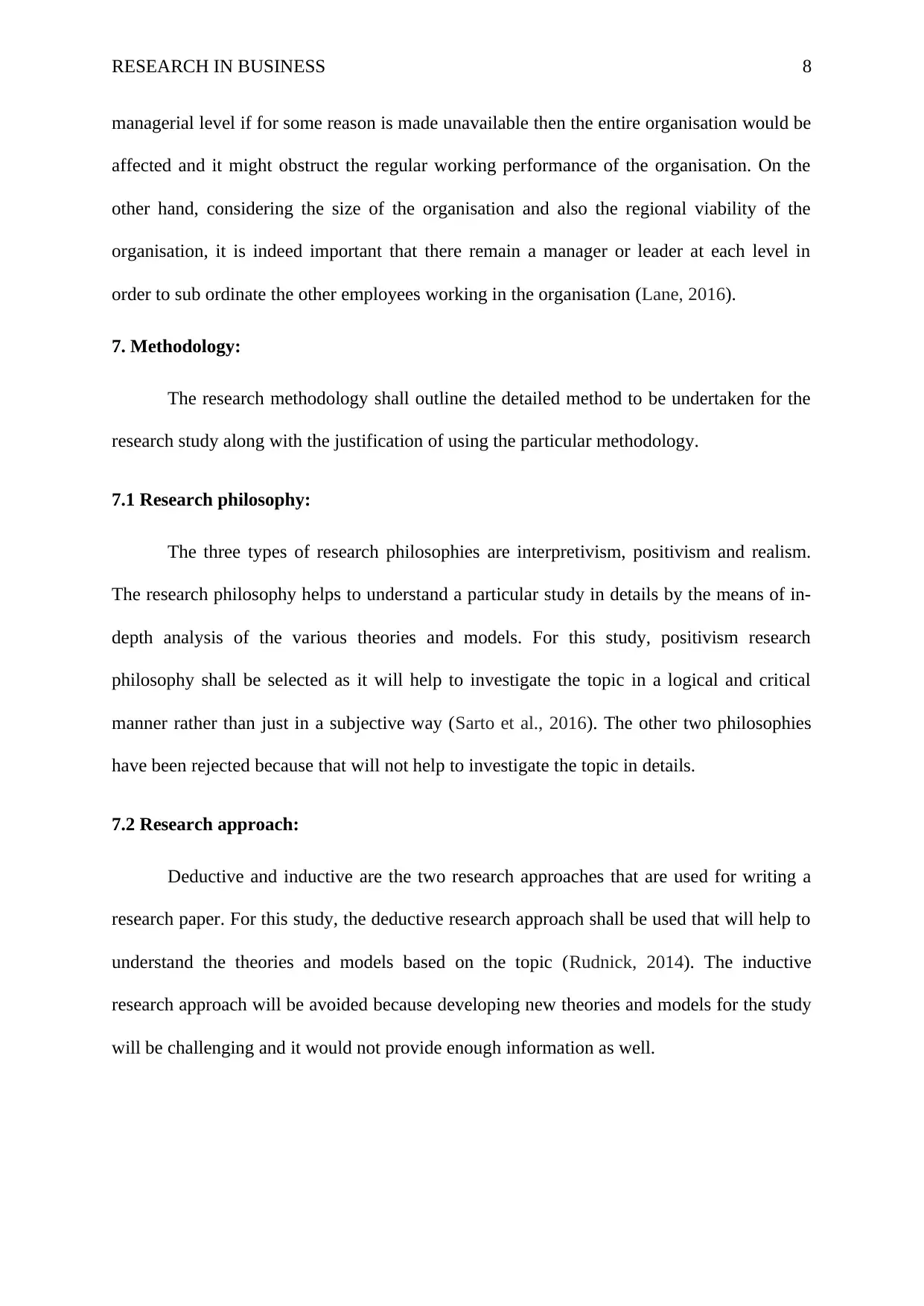
RESEARCH IN BUSINESS 8
managerial level if for some reason is made unavailable then the entire organisation would be
affected and it might obstruct the regular working performance of the organisation. On the
other hand, considering the size of the organisation and also the regional viability of the
organisation, it is indeed important that there remain a manager or leader at each level in
order to sub ordinate the other employees working in the organisation (Lane, 2016).
7. Methodology:
The research methodology shall outline the detailed method to be undertaken for the
research study along with the justification of using the particular methodology.
7.1 Research philosophy:
The three types of research philosophies are interpretivism, positivism and realism.
The research philosophy helps to understand a particular study in details by the means of in-
depth analysis of the various theories and models. For this study, positivism research
philosophy shall be selected as it will help to investigate the topic in a logical and critical
manner rather than just in a subjective way (Sarto et al., 2016). The other two philosophies
have been rejected because that will not help to investigate the topic in details.
7.2 Research approach:
Deductive and inductive are the two research approaches that are used for writing a
research paper. For this study, the deductive research approach shall be used that will help to
understand the theories and models based on the topic (Rudnick, 2014). The inductive
research approach will be avoided because developing new theories and models for the study
will be challenging and it would not provide enough information as well.
managerial level if for some reason is made unavailable then the entire organisation would be
affected and it might obstruct the regular working performance of the organisation. On the
other hand, considering the size of the organisation and also the regional viability of the
organisation, it is indeed important that there remain a manager or leader at each level in
order to sub ordinate the other employees working in the organisation (Lane, 2016).
7. Methodology:
The research methodology shall outline the detailed method to be undertaken for the
research study along with the justification of using the particular methodology.
7.1 Research philosophy:
The three types of research philosophies are interpretivism, positivism and realism.
The research philosophy helps to understand a particular study in details by the means of in-
depth analysis of the various theories and models. For this study, positivism research
philosophy shall be selected as it will help to investigate the topic in a logical and critical
manner rather than just in a subjective way (Sarto et al., 2016). The other two philosophies
have been rejected because that will not help to investigate the topic in details.
7.2 Research approach:
Deductive and inductive are the two research approaches that are used for writing a
research paper. For this study, the deductive research approach shall be used that will help to
understand the theories and models based on the topic (Rudnick, 2014). The inductive
research approach will be avoided because developing new theories and models for the study
will be challenging and it would not provide enough information as well.
⊘ This is a preview!⊘
Do you want full access?
Subscribe today to unlock all pages.

Trusted by 1+ million students worldwide
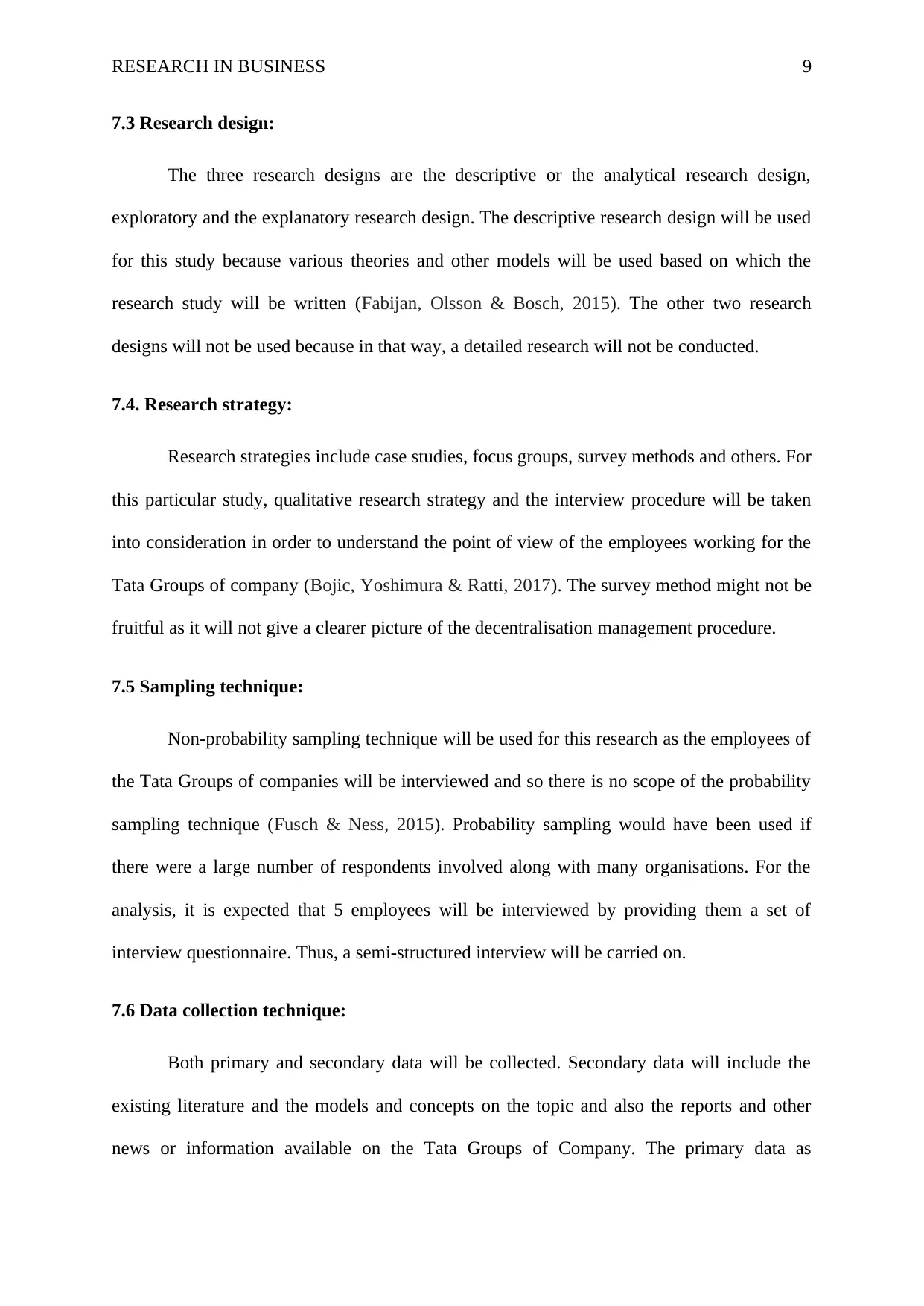
RESEARCH IN BUSINESS 9
7.3 Research design:
The three research designs are the descriptive or the analytical research design,
exploratory and the explanatory research design. The descriptive research design will be used
for this study because various theories and other models will be used based on which the
research study will be written (Fabijan, Olsson & Bosch, 2015). The other two research
designs will not be used because in that way, a detailed research will not be conducted.
7.4. Research strategy:
Research strategies include case studies, focus groups, survey methods and others. For
this particular study, qualitative research strategy and the interview procedure will be taken
into consideration in order to understand the point of view of the employees working for the
Tata Groups of company (Bojic, Yoshimura & Ratti, 2017). The survey method might not be
fruitful as it will not give a clearer picture of the decentralisation management procedure.
7.5 Sampling technique:
Non-probability sampling technique will be used for this research as the employees of
the Tata Groups of companies will be interviewed and so there is no scope of the probability
sampling technique (Fusch & Ness, 2015). Probability sampling would have been used if
there were a large number of respondents involved along with many organisations. For the
analysis, it is expected that 5 employees will be interviewed by providing them a set of
interview questionnaire. Thus, a semi-structured interview will be carried on.
7.6 Data collection technique:
Both primary and secondary data will be collected. Secondary data will include the
existing literature and the models and concepts on the topic and also the reports and other
news or information available on the Tata Groups of Company. The primary data as
7.3 Research design:
The three research designs are the descriptive or the analytical research design,
exploratory and the explanatory research design. The descriptive research design will be used
for this study because various theories and other models will be used based on which the
research study will be written (Fabijan, Olsson & Bosch, 2015). The other two research
designs will not be used because in that way, a detailed research will not be conducted.
7.4. Research strategy:
Research strategies include case studies, focus groups, survey methods and others. For
this particular study, qualitative research strategy and the interview procedure will be taken
into consideration in order to understand the point of view of the employees working for the
Tata Groups of company (Bojic, Yoshimura & Ratti, 2017). The survey method might not be
fruitful as it will not give a clearer picture of the decentralisation management procedure.
7.5 Sampling technique:
Non-probability sampling technique will be used for this research as the employees of
the Tata Groups of companies will be interviewed and so there is no scope of the probability
sampling technique (Fusch & Ness, 2015). Probability sampling would have been used if
there were a large number of respondents involved along with many organisations. For the
analysis, it is expected that 5 employees will be interviewed by providing them a set of
interview questionnaire. Thus, a semi-structured interview will be carried on.
7.6 Data collection technique:
Both primary and secondary data will be collected. Secondary data will include the
existing literature and the models and concepts on the topic and also the reports and other
news or information available on the Tata Groups of Company. The primary data as
Paraphrase This Document
Need a fresh take? Get an instant paraphrase of this document with our AI Paraphraser
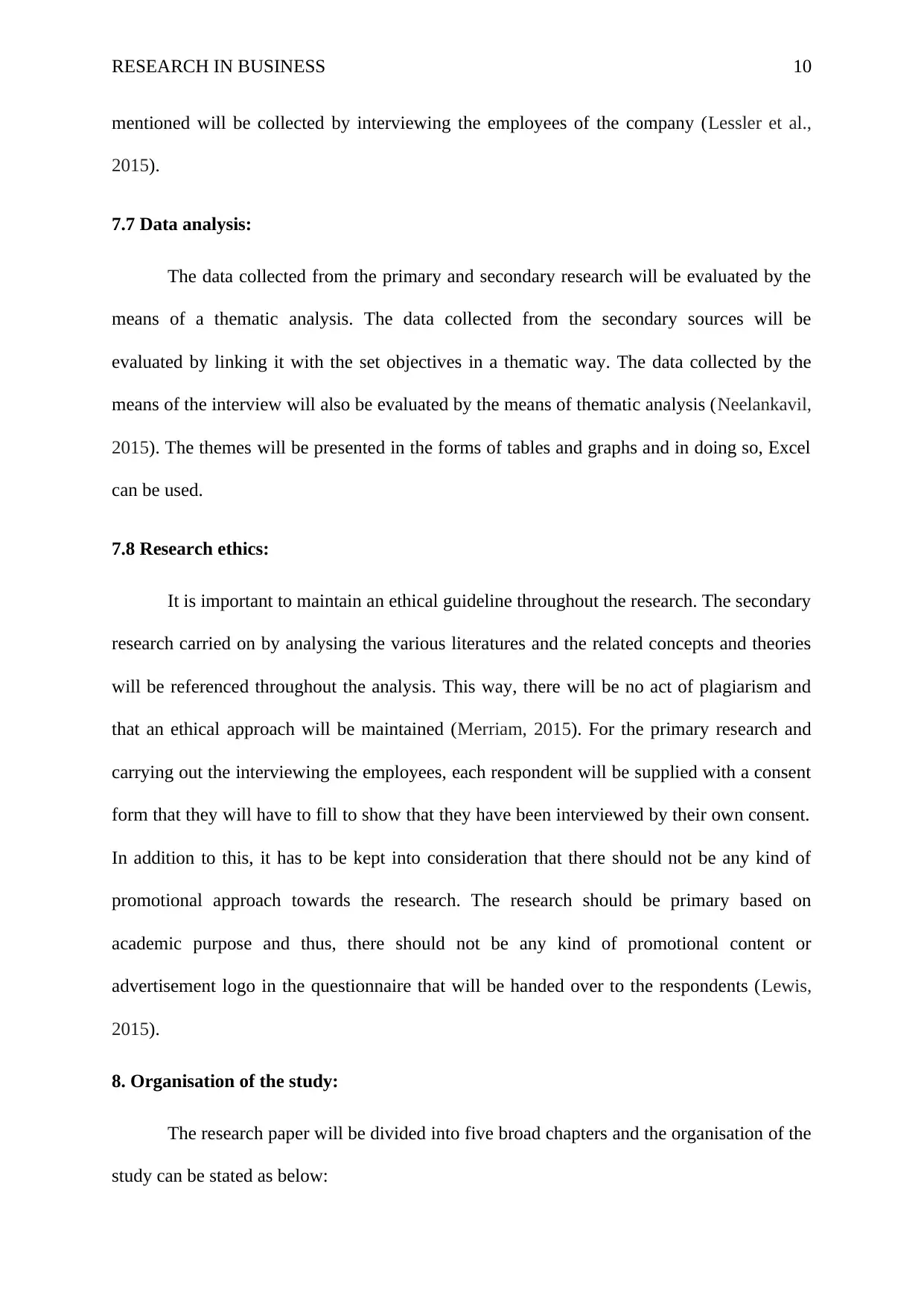
RESEARCH IN BUSINESS 10
mentioned will be collected by interviewing the employees of the company (Lessler et al.,
2015).
7.7 Data analysis:
The data collected from the primary and secondary research will be evaluated by the
means of a thematic analysis. The data collected from the secondary sources will be
evaluated by linking it with the set objectives in a thematic way. The data collected by the
means of the interview will also be evaluated by the means of thematic analysis (Neelankavil,
2015). The themes will be presented in the forms of tables and graphs and in doing so, Excel
can be used.
7.8 Research ethics:
It is important to maintain an ethical guideline throughout the research. The secondary
research carried on by analysing the various literatures and the related concepts and theories
will be referenced throughout the analysis. This way, there will be no act of plagiarism and
that an ethical approach will be maintained (Merriam, 2015). For the primary research and
carrying out the interviewing the employees, each respondent will be supplied with a consent
form that they will have to fill to show that they have been interviewed by their own consent.
In addition to this, it has to be kept into consideration that there should not be any kind of
promotional approach towards the research. The research should be primary based on
academic purpose and thus, there should not be any kind of promotional content or
advertisement logo in the questionnaire that will be handed over to the respondents (Lewis,
2015).
8. Organisation of the study:
The research paper will be divided into five broad chapters and the organisation of the
study can be stated as below:
mentioned will be collected by interviewing the employees of the company (Lessler et al.,
2015).
7.7 Data analysis:
The data collected from the primary and secondary research will be evaluated by the
means of a thematic analysis. The data collected from the secondary sources will be
evaluated by linking it with the set objectives in a thematic way. The data collected by the
means of the interview will also be evaluated by the means of thematic analysis (Neelankavil,
2015). The themes will be presented in the forms of tables and graphs and in doing so, Excel
can be used.
7.8 Research ethics:
It is important to maintain an ethical guideline throughout the research. The secondary
research carried on by analysing the various literatures and the related concepts and theories
will be referenced throughout the analysis. This way, there will be no act of plagiarism and
that an ethical approach will be maintained (Merriam, 2015). For the primary research and
carrying out the interviewing the employees, each respondent will be supplied with a consent
form that they will have to fill to show that they have been interviewed by their own consent.
In addition to this, it has to be kept into consideration that there should not be any kind of
promotional approach towards the research. The research should be primary based on
academic purpose and thus, there should not be any kind of promotional content or
advertisement logo in the questionnaire that will be handed over to the respondents (Lewis,
2015).
8. Organisation of the study:
The research paper will be divided into five broad chapters and the organisation of the
study can be stated as below:

RESEARCH IN BUSINESS 11
Chapter 1: Introduction
The aim of this chapter is to introduce the topic and to give a clear description of the
rationale of the topic. The chapter shall include a brief background of the study, a discussion
on the previous studies related to the topic, the research aims and objectives along with the
research questions. In addition to this, the significance and the justification of the study will
also be given.
Chapter 2: Literature review
Based on the objectives of the study, the literature review will be divided into various
themes and sub-themes covering the main points based on which the conceptual framework
will be framed. These themes will be evaluated on the basis of the existing literature. A
critical analysis of the peer-reviewed journals will be carried on in this chapter. Supporting
theories and models shall be evaluated as well.
Chapter 3: Research methodology
A detailed discussion on the methodology undertaken to carry out the research will be
discussed in this section. This shall include the research philosophy, approach, design,
strategy and other methods undertaken. This methodology will be written along with the
proper justification of undertaking such research method.
Chapter 4: Analysis of the data
The analysis of both primary and secondary data will be done in this section of the
study. The primary data will be represented in the forms of tables and charts as well as a
thematic analysis approach will be undertaken. The primary data analysis shall also be linked
with the secondary data collected.
Chapter 5: Conclusion and recommendation
Chapter 1: Introduction
The aim of this chapter is to introduce the topic and to give a clear description of the
rationale of the topic. The chapter shall include a brief background of the study, a discussion
on the previous studies related to the topic, the research aims and objectives along with the
research questions. In addition to this, the significance and the justification of the study will
also be given.
Chapter 2: Literature review
Based on the objectives of the study, the literature review will be divided into various
themes and sub-themes covering the main points based on which the conceptual framework
will be framed. These themes will be evaluated on the basis of the existing literature. A
critical analysis of the peer-reviewed journals will be carried on in this chapter. Supporting
theories and models shall be evaluated as well.
Chapter 3: Research methodology
A detailed discussion on the methodology undertaken to carry out the research will be
discussed in this section. This shall include the research philosophy, approach, design,
strategy and other methods undertaken. This methodology will be written along with the
proper justification of undertaking such research method.
Chapter 4: Analysis of the data
The analysis of both primary and secondary data will be done in this section of the
study. The primary data will be represented in the forms of tables and charts as well as a
thematic analysis approach will be undertaken. The primary data analysis shall also be linked
with the secondary data collected.
Chapter 5: Conclusion and recommendation
⊘ This is a preview!⊘
Do you want full access?
Subscribe today to unlock all pages.

Trusted by 1+ million students worldwide
1 out of 19
Related Documents
Your All-in-One AI-Powered Toolkit for Academic Success.
+13062052269
info@desklib.com
Available 24*7 on WhatsApp / Email
![[object Object]](/_next/static/media/star-bottom.7253800d.svg)
Unlock your academic potential
Copyright © 2020–2025 A2Z Services. All Rights Reserved. Developed and managed by ZUCOL.





